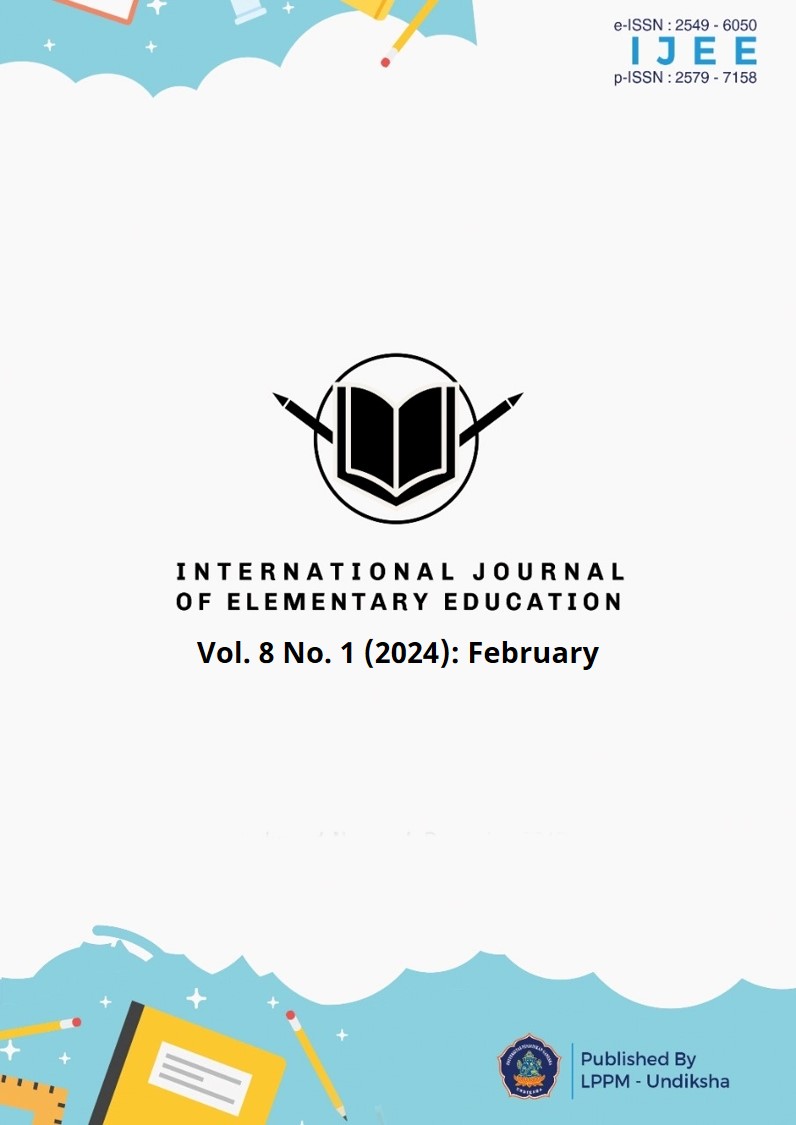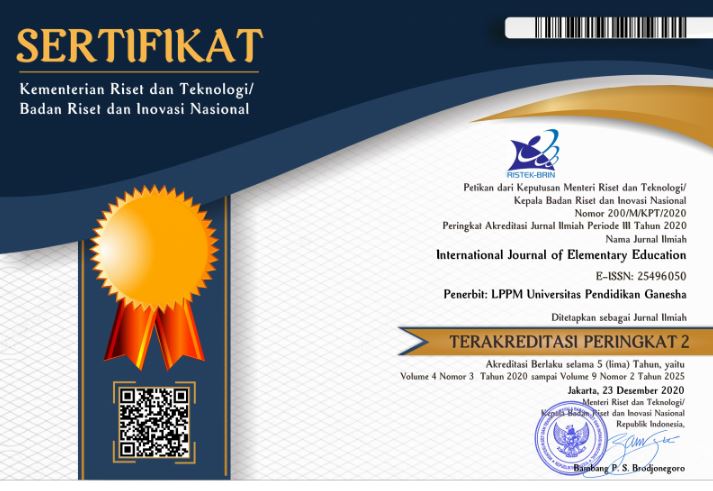Diagnosing Elementary School Students' Representation of Light Concept Through the Five-tier Diagnostic Test
DOI:
https://doi.org/10.23887/ijee.v8i1.68967Keywords:
Five-tier diagnostic test, Representation, Light concepts, Elementary schoolAbstract
Elementary school students do not yet have a scientific understanding of light. For example, they represent vision as the process of objects being hit by light and the eye being automatically able to see them. Their verbal and visual representations present irrelevance to scientific beliefs. Students need to understand science more comprehensively through multiple-representation learning. The relevant diagnostic tests are needed to find out student multiple-representation profiles. However, diagnostic tests identifying multiple-representation profiles of elementary school students are still rare. This paper aims to communicate the results of development, validity, and reliability, as well as trials of the five-tier diagnostic test (5TDT) in measuring multiple representations of elementary school students about light concepts. The 5TDT is a developed version of the four-tier where there are answer choices and reasons and the level of student confidence in answering both. A package of 15 questions was developed, tested for readability by elementary school teachers and students, and then piloted. Two hundred twenty-seven elementary school students who had studied the concept of light attempted this test. Internal validity was submitted to five experts and showed valid results with several improvement notes. Meanwhile, the results of statistical tests on external validity and reliability show that the five-tier diagnostic test is valid and reliable. The five-tier diagnostic test can measure the diversity of students' representation of their ideas regarding the light concept with more precision. It is shown that they are dominating the Lack of Representation (LOR) level of 39% and Misconception (MIS) level of 31%.
References
Ainsworth, S. (2006). DeFT: A conceptual framework for considering learning with multiple representations. Learning and Instruction, 16(3), 183–198. https://doi.org/10.1016/j.learninstruc.2006.03.001.
Akkus, H., Kadayifci, H., & Atasoy, B. (2011). Development and application of a twotier diagnostic test to assess secondary students’ understanding of chemical equilibrium concepts. Journal of Baltic Science Education, 10(3), 146–155. https://doi.org/http://oaji.net/articles/2014/987-1410547169.pdf.
Anam, R. S., Widodo, A., Sopandi, W., & Wu, H. K. (2019). Developing a five-tier diagnostic test to identify students’ misconceptions in science: an example of the heat transfer concepts. Elementary Education Online, 18(3), 1014–1029. https://doi.org/10.17051/ilkonline.2019.609690.
Asriadi, M., & Istiyono, E. (2022). Multiple representation ability of high school students in physics: a study of modern response theory. Thabiea: Journal of Natural Science Teaching, 5(1), 85–97. https://doi.org/10.21043/thabiea.v5i1.12550.
Aydeniz, M., Bilican, K., & Kirbulut, Z. D. (2017). Exploring pre-service elementary science teachers’ conceptual understanding of particulate nature of matter through three-tier diagnostic test. International Journal of Education in Mathematics, Science and Technology, 5(3), 221–221. https://doi.org/10.18404/ijemst.296036.
Banawi, A., Sopandi, W., Kadarohman, A., & Solehuddin, M. (2022). Five-tier multiple-choice diagnostic test development: empirical evidences to improve students’ science literacy. Proceedings of the International Conference on Madrasah Reform 2021 (ICMR 2021), 633(Icmr 2021), 131–138. https://doi.org/10.2991/assehr.k.220104.020.
Cahyanto, M. A. S., Ashadi, A., & Saputro, S. (2019). An analysis of gender difference on students’ misconceptions in learning the material classification and its changes. Jurnal Inovasi Pendidikan IPA, 5(2), 157–167. https://doi.org/http://dx.doi.org/10.21831/jipi.v5i2.26613.
Caleon, I. S., & Subramaniam, R. (2010). Do students know What they know and what they don’t know? Using a four-tier diagnostic test to assess the nature of students’ alternative conceptions. Research in Science Education, 40(3), 313–337. https://doi.org/10.1007/s11165-009-9122-4.
Çelikkanlı, N. Ö., & Kızılcık, H. Ş. (2022). A review of studies about four-tier diagnostic tests in physics education. Journal of Turkish Science Education, 19(4), 1291–1311. https://doi.org/10.36681/tused.2022.175.
Chusni, M. M. (2022). Effectiveness of discovery learning-based multiple representation module on enhancing the critical thinking skills of the students with high and low science process skills. Jurnal Inovasi Pendidikan IPA, 8(2), 199–209. https://doi.org/http://dx.doi.org/10.21831/jipi.v8i2.49340.
Dewi, S. P., Lidyawati, Y., & Destiansari, E. (2022). How is the implementation of diagnostic tests in biology learning in south sumatra? Jurnal Penelitian Pendidikan IPA, 8(6), 2605–2612. https://doi.org/10.29303/jppipa.v8i6.1859.
Dikmenli, M. (2010). Misconceptions of cell division held by student teachers in biology: A drawing analysis. Scientific Research and Essays, 5(2), 235–247. https://doi.org/https://doi.org/10.5897/SRE.9000654.
Dirman, H. M., Mufit, F., & Festiyed, F. (2022). Review and comparison of four-tier multiple choice and five-tier multiple choice diagnostic tests to identify mastery of physics concepts. Jurnal Penelitian Pendidikan IPA, 8(1), 1–12. https://doi.org/10.29303/jppipa.v8i1.838.
Fajriyyah, N., & Ermawati, F. (2020). The validity and reliability of five-tier conception diagnostic test for kinetic theory of gases. Inovasi Pendidikan Fisika, 09(02), 126–132. https://doi.org/https://doi.org/10.26740/ipf.v9n2.p%25p.
Fatimah, S. (2016). Analisis multirepresentasi mahasiswa pgsd pada konsep gelombang dan bunyi. Premiere Educandum, 6(2), 174–179. https://doi.org/http://doi.org/10.25273/pe.v6i02.809.
Halverson, K. L., & Friedrichsen, P. (2013). Learning Tree Thinking: Developing a New Framework of Representational Competence. In D. F. Treagust & C.-Y. Tsui (Eds.), Multiple Representations in Biological Education. Dordrecht: Springer.
Handayani, W., Sinaga, P., & Suhandi, A. (2021). Triple step writing strategy: Meningkatkan keterampilan menulis materi ajar multimodus representasi pada mahasiswa calon guru fisika. Jurnal Inovasi Pendidikan IPA, 7(1), 47–60. https://doi.org/http://dx.doi.org/10.21831/jipi.v7i1.37781.
Harfiani, D. R., & Desstya, A. (2023). Mapping science learning in the 2013 curriculum and merdeka belajar curriculum. Jurnal Ilmiah Sekolah Dasar, 7(2), 384–395. https://doi.org/https://doi.org/10.23887/jisd.v7i2.58291.
Hoban, G., Loughran, J., & Nielsen, W. (2011). Slowmation: Preservice elementary teachers representing science knowledge through creating multimodal digital animations. Journal of Research in Science Teaching, 48(9), 985–1009. https://doi.org/10.1002/tea.20436.
Jampel, I. N., Fahrurrozi, Artawan, G., Widiana, I. W., Parmiti, D. P., & Hellman, J. (2018). Studying natural science in elementary school using nos-oriented cooperative learning model with the NHT type. Jurnal Pendidikan IPA Indonesia, 7(2), 138–146. https://doi.org/10.15294/jpii.v7i2.9863.
Juita, Z., Sundari, P. D., Sari, S. Y., & Rahim, F. R. (2023). Identification of physics misconceptions using five-tier diagnostic test: newton’s law of gravitation context. Jurnal Penelitian Pendidikan IPA (JPPIPA), 9(8), 5954–5963. https://doi.org/10.29303/jppipa.v9i8.3147.
Juliani, J., Yusrizal, Y., & Huda, I. (2021). Development of four tier multiple choice diagnostic tests to know students’ misconceptions in science learning. Jurnal Penelitian Pendidikan IPA, 7(4), 763–769. https://doi.org/10.29303/jppipa.v7i4.854.
Kaltakci-Gurel, D., Eryilmaz, A., & McDermott, L. C. (2017). Development and application of a four-tier test to assess pre-service physics teachers’ misconceptions about geometrical optics. Research in Science and Technological Education, 35(2), 238–260. https://doi.org/10.1080/02635143.2017.1310094.
Kartimi, K., Yunita, Y., Fuadi, F. N., & Addiin, I. (2021). A four-tier diagnostic instrument: an analysis of elementary student misconceptions in science topic. Jurnal Penelitian Pendidikan IPA, 7(SpecialIssue), 61–68. https://doi.org/10.29303/jppipa.v7ispecialissue.1022.
Kelana, J. B., Robandi, B., & Widodo, A. (2022). Inquiry model: How to improve the ability of the nature of science and its aspects in elementary school. International Journal of Elementary Education, 6(2), 325–332. Retrieved from https://doi.org/10.23887/ijee.v6i2.45611.
Kokologiannaki, V., & Ravanis, K. (2012). Mental representations of sixth graders in Greece for the mechanism of vision in conditions of day and night. International Journal of Research In Education Methodology Council for Innovative Research, 2(1), 78–83. https://doi.org/10.24297/ijrem.v2i1.4111.
Köse, S. (2008). Diagnosing student misconceptions: Using drawings as a research method. World Applied Sciences Journal, 3(2), 283–293. Retrieved from http://idosi.org/wasj/wasj3(2)/20.pdf.
Lim, H. L., & Poo, Y. P. (2021). Diagnostic test to assess misconceptions on photosynthesis and plant respiration: Is it valid and reliable? Jurnal Pendidikan IPA Indonesia, 10(2), 241–252. https://doi.org/10.15294/jpii.v10i2.26944.
Margunayasa, I. G., Dantes, N., Marhaeni, . A. I. N., & Suastra, I. W. (2021). Reducing misconceptions of elementary school students through guided inquiry learning. Jurnal Ilmiah Sekolah Dasar, 5(4), 729–736. https://doi.org/10.23887/jisd.v5i4.40388.
Masfuah, S., Fakhriyah, F., Wilujeng, I., & Rosana, D. (2021). Diagnostic test profile of scientific literacy to measure student’s misconceptions in science concept course. ELEMENTARY: Islamic Teacher Journal, 9(1), 35–56. https://doi.org/10.21043/elementary.v9i1.10382.
Mubarak, S., & Yahdi. (2020). Identifying undergraduate students’ misconceptions in understanding acid base materials. Jurnal Pendidikan IPA Indonesia, 9(2), 276–286. https://doi.org/10.15294/jpii.v9i2.23193.
Mubarokah, F. D., Mulyani, S., & Indriyanti, N. Y. (2018). Identifying students’ misconceptions of acid-base concepts using a three-tier diagnostic test: A case of Indonesia and Thailand. Journal of Turkish Science Education, 15(Special Issue), 51–58. Retrieved from https://api.elsevier.com/content/abstract/scopus_id/85077227003.
Park, J., Chang, J., Tang, K. S., Treagust, D. F., & Won, M. (2020). Sequential patterns of students’ drawing in constructing scientific explanations: focusing on the interplay among three levels of pictorial representation. International Journal of Science Education, 42(5), 677–702. https://doi.org/10.1080/09500693.2020.1724351.
Park, J., Tang, K. S., & Chang, J. (2021). Plan-Draw-Evaluate (PDE) pattern in students’ collaborative drawing: Interaction between visual and verbal modes of representation. Science Education, 105(5), 1013–1045. https://doi.org/10.1002/sce.21668.
Prain, V., & Hand, B. (2016). Learning Science Through Learning to Use Its Languages. In B. Hand, M. McDermott, & V. Prain (Eds.), Using Multimodal Representations to Support Learning in the Science Classroom. Switzerland: Springer International Publishing.
Putri, R. A. H., Widodo, A., & Rusyati, L. (2021). Developing a four-tier diagnostic test to identify students’ conception on light and optic topic. Journal of Physics: Conference Series, 2098(1), 1–6. https://doi.org/10.1088/1742-6596/2098/1/012008.
Resbiantoro, G., Setiani, R., & Dwikoranto. (2022). A review of misconception in physics: The diagnosis, causes, and remediation. Journal of Turkish Science Education, 19(2), 403–427. https://doi.org/10.36681/tused.2022.128.
Riduwan, & Akdon. (2020). Rumus dan Data dalam Aplikasi Statistika. Bandung: Alfabeta.
Schultz, M., Lawrie, G. A., Bailey, C. H., Bedford, S. B., Dargaville, T. R., O’Brien, G., … Wright, A. H. (2017). Evaluation of diagnostic tools that tertiary teachers can apply to profile their students’ conceptions. International Journal of Science Education, 39(5), 565–586. https://doi.org/10.1080/09500693.2017.1296980.
Soeharto, Csapó, B., Sarimanah, E., Dewi, F. I., & Sabri, T. (2019). A review of students’ common misconceptions in science and their diagnostic assessment tools. Jurnal Pendidikan IPA Indonesia, 8(2), 247–266. https://doi.org/10.15294/jpii.v8i2.18649.
Syahmel, S., & Jumadi, J. (2019). Discovery learning using multiple representation model for enhancing scientific processing and critical thinking skills of the students. Jurnal Inovasi Pendidikan IPA, 5(2), 180–194. https://doi.org/10.21831/jipi.v5i2.26704.
Tang, K. S., Delgado, C., & Moje, E. B. (2014). An integrative framework for the analysis of multiple and multimodal representations for meaning-making in science education. Science Education, 98(2), 305–326. https://doi.org/10.1002/sce.21099.
Uzun, S., Alev, N., & Karal, I. S. (2013). A cross-age study of an understanding of light and sight concepts in physics. Science Education International, 24(2), 129–149. Retrieved from https://files.eric.ed.gov/fulltext/EJ1015829.pdf.
Widiyatmoko, A., & Shimizu, K. (2018). The development of two-tier multiple choice test to assess students’ conceptual understanding about light and optical instruments. Jurnal Pendidikan IPA Indonesia, 7(4), 491–501. https://doi.org/10.15294/jpii.v7i4.16591.
Wilson, R. E., & Bradbury, L. U. (2021). Assessing early primary students’ growth in a science unit using multiple modes of representation: investigating the promise of explicit drawing instruction. International Journal of Science Education, 43(8), 1341–1364. https://doi.org/10.1080/09500693.2021.1909774.
Wiyantara, A., Widodo, A., & Prima, E. C. (2021). Identify students’ conception and level of representations using five-tier test on wave concepts. Journal of Physics: Conference Series, 1806(1), 1–7. https://doi.org/10.1088/1742-6596/1806/1/012137.
Xu, L., Prain, V., & Speldewinde, C. (2021). Challenges in designing and assessing student interdisciplinary learning of optics using a representation construction approach. International Journal of Science Education, 43(6), 844–867. https://doi.org/10.1080/09500693.2021.1889070.
Yeo, J.-H., Yang, H.-H., & Cho, I.-H. (2022). Using a three-tier multiple-choice diagnostic instrument toward alternative conceptions among lower-secondary school students in taiwan: Taking ecosystems unit as an example. Journal of Baltic Science Education, 21(1), 69–83. https://doi.org/10.33225/jbse/22.21.69.
Downloads
Published
How to Cite
Issue
Section
License
Copyright (c) 2024 Yogi Kuncoro Adi, Ari Widodo, Wahyu Sopandi, Muslim

This work is licensed under a Creative Commons Attribution-ShareAlike 4.0 International License.
Authors who publish with the International Journal of Elementary Education agree to the following terms:
- Authors retain copyright and grant the journal the right of first publication with the work simultaneously licensed under a Creative Commons Attribution License (CC BY-SA 4.0) that allows others to share the work with an acknowledgment of the work's authorship and initial publication in this journal.
- Authors are able to enter into separate, additional contractual arrangements for the non-exclusive distribution of the journal's published version of the work (e.g., post it to an institutional repository or publish it in a book), with an acknowledgment of its initial publication in this journal.
- Authors are permitted and encouraged to post their work online (e.g., in institutional repositories or on their website) prior to and during the submission process, as it can lead to productive exchanges, as well as earlier and greater citation of published work. (See The Effect of Open Access)









